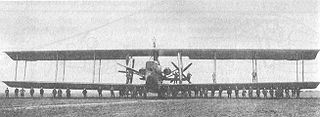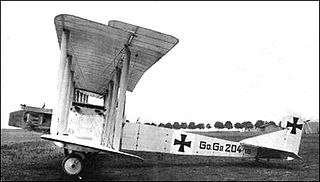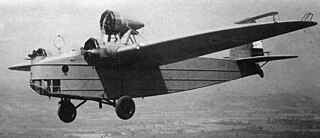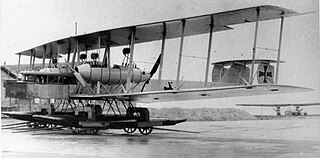
The Zeppelin-Staaken R.VI was a four-engined German biplane strategic bomber of World War I, and the only Riesenflugzeug design built in any quantity.

A Riesenflugzeug, sometimes colloquially referred to in English as an R-plane, was any member of a class of large World War I German bombers, possessing at least three aircraft engines, although usually four or more engines. These large multi-engine aircraft could fly several hours with larger bomb loads than the smaller Grossflugzeug bombers such as the Gotha G.V.

The Gotha G.II series was a heavy bomber used by the Luftstreitkräfte during World War I.

The Gotha G.IV was a heavy bomber used by the Luftstreitkräfte during World War I. It was the first mass-produced relatively large airplane.

The Dornier Do Y was a trimotor German monoplane bomber of the early 1930s designed by Dornier Flugzeugwerke to an order by the Royal Yugoslav Air Force (RYAF). The Yugoslavs originally intended to use war reparations to pay for them, but ultimately had to use their own funds. Only a pair of aircraft were initially ordered to give the Yugoslavs experience with multi-engine bombers and Dornier failed to sell any more Do Y's. Two improved versions were subsequently built on speculation, but failed to find purchasers until the RYAF bought them in 1935.

The Zeppelin-Lindau Rs.I was a large three-engined biplane flying boat designed by Claudius Dornier and built during 1914–15 on the German side of Lake Constance. It was destroyed in a storm.
The Siemens-Schuckert R.I was a bomber aircraft built in Germany during World War I. It was originally ordered as the Siemens-Schuckert G.I prior to the German Inspectorate of Flying Troops adopting the "R" classification for multi-engine aircraft in late 1915. Some sources refer to the aircraft as the Siemens-Schuckert Steffen R.I, including the name of the brothers that designed it.

The Siemens-Schuckert Forssman was a prototype bomber aircraft designed and built in Germany in 1914 and 1915. When its performance proved inadequate for its intended role, even after numerous modifications, the German Inspectorate of Flying Troops eventually accepted it into service as a trainer. Shortly after its acceptance into military service, the aircraft's fuselage fractured while on the ground, ending its career.
The Siemens-Schuckert R.III was a prototype bomber aircraft built in Germany during World War I. It was one of six aircraft based on the Siemens-Schuckert R.I that were originally intended to be identical, but which each developed in a different direction and were designated as different aircraft types by the German Inspectorate of Flying Troops. The aircraft's development was impeded by the unreliability of its Maybach HS engines, and when it was eventually accepted for military service, it was only in a training role.
The Siemens-Schuckert R.IV was a bomber aircraft built in Germany during World War I. It was one of six aircraft based on the Siemens-Schuckert R.I that were originally intended to be identical, but which each developed in a different direction and were designated as different aircraft types by the German Inspectorate of Flying Troops. The Maybach HS engines specified by the Idflieg proved unreliable, but with these engines were replaced by Benz Bz.IV engines, the R.IV saw service on the Eastern Front before being relegated to training duties.

The Zeppelin-Staaken R.XVI(Av) was a very large bomber (Riesenflugzeug), designed and built in Germany during 1918.
The Zeppelin-Staaken R.VII was six-engined large bomber - a Riesenflugzeug - of Imperial Germany, intended to be less vulnerable than the airships in use at the time.

The Zeppelin-Staaken Riesenflugzeuge were a series of very large bomber aircraft - Riesenflugzeuge, usually powered by four or more engines, designed and built in Germany from 1915 to 1919.

The Zeppelin-Lindau Rs.II was a biplane flying boat, designed by Claudius Dornier as a follow-on to his Zeppelin-Lindau Rs.I and built during 1914–1915 on the German side of Lake Constance. Initially this aircraft was powered by three engines mounted inside the hull driving three pusher propellers via gearboxes and shafts. The later version was powered by four engines in two push-pull nacelles mounted between the wings.

The Zeppelin D.I, or Zeppelin-Lindau D.I or Zeppelin D.I (Do), as named in German documents, also sometimes referred to postwar as the Dornier D.I or Dornier-Zeppelin D.I, for the designer, was a single-seat all-metal stressed skin monocoque cantilever-wing biplane fighter, developed by Claude Dornier while working for Luftschiffbau Zeppelin at their Lindau facility. It was too late to see operational service with the German Air Force (Luftstreitkräfte) during World War I.

The Zeppelin-Lindau Rs.IV was a Riesenflugzeug monoplane all metal flying boat with a stressed skin hull and fuselage developed for the Imperial German Navy to perform long range patrols over the North Sea. It had been developed by Claudius Dornier while working for Zeppelin in the town of Lindau.

The Zeppelin-Lindau CL.II was a German single-engine two-seat biplane with an all metal structure, built by Zeppelin-Lindau during World War I.
The Hansa-Brandenburg C.II, company designation K,, was a two-seat reconnaissance aircraft built in Germany by Hansa-Brandenburg in World War I, powered by Mercedes D.III or Hiero 6 water-cooled in-line piston engines.

The Zeppelin-Lindau Gs.I, often known post-WWI as the Dornier Gs.I after its designer Claude Dornier, was a civil flying boat developed immediate post-war from a military prototype. Its passenger cabin seated six. Only one was completed, and that was eventually scuttled to keep it out of Allied hands. Another of the military prototypes was intended to have a bigger, nine seat cabin and other refinements but the Gs.II was incomplete when discovered by Allied inspectors.

The Zeppelin-Staaken L was an experimental long-range maritime patrol floatplane developed during World War I by Zeppelin-Staaken for the Imperial German Navy's Naval Air Service. Derived from the Zeppelin-Staaken R.VI heavy bomber, it was a large, four-engine aircraft with its engines grouped in tractor-pusher pairs between the wings. A single aircraft was ordered for evaluation purposes in 1917.














